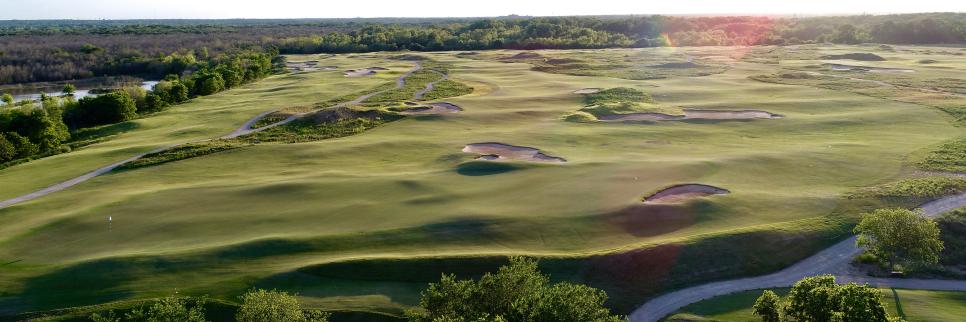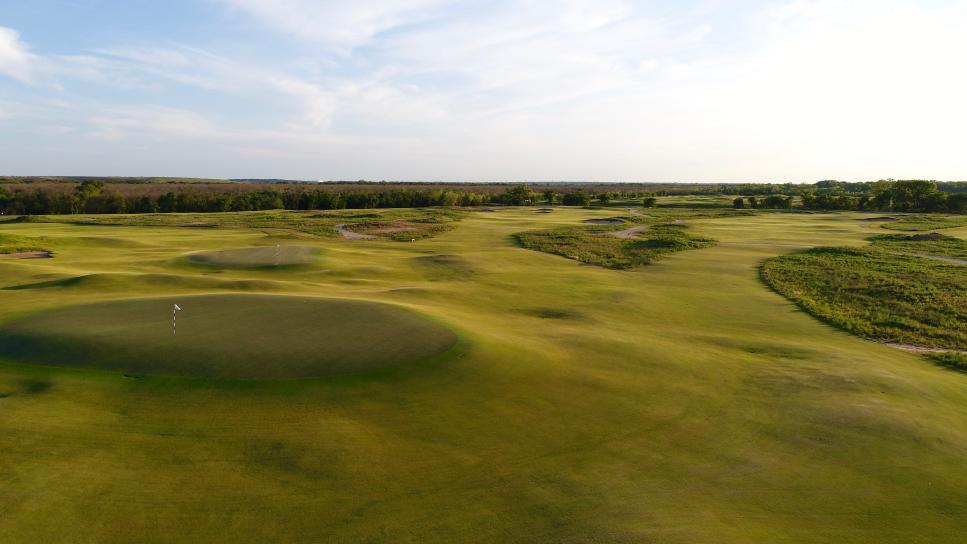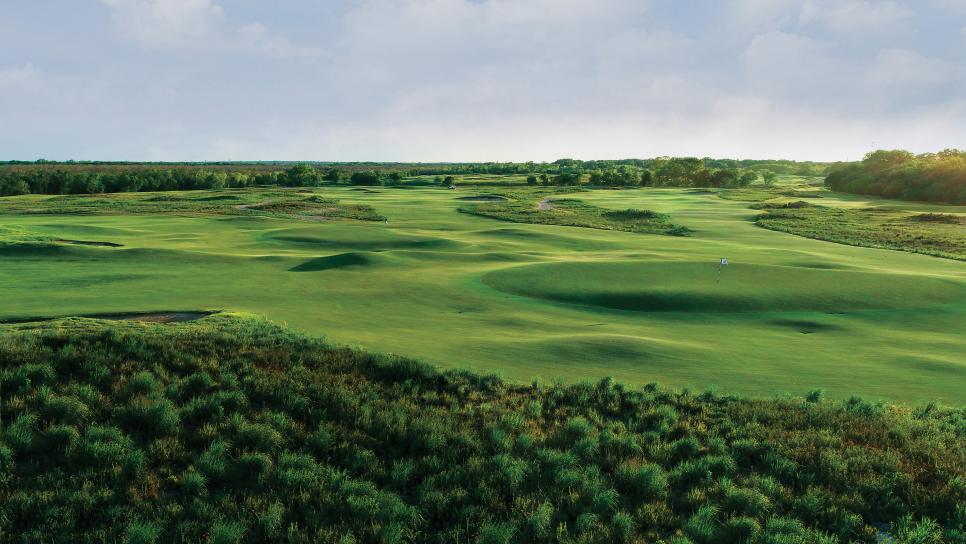The world changed with the Trinity Test on July 16, 1945. That day, the world’s first nuclear bomb was detonated at a test site in New Mexico, and the future has been clouded ever since.
We’re not sure how much the golf world will change when Trinity Forest Golf Club is unveiled to the world this May as the new host of the PGA Tour’s Byron Nelson Classic. But we are certain the course will have a far-reaching impact on those who see and play it. Enough impact that Golf Digest is awarding its 2018 Green Star award for outstanding environmental practices to Trinity Forest.
This is a golf course that’s unique in many respects. For starters, this 18, just 12 minutes south of downtown Dallas, was built atop a landfill, always a noble community service for golf, although such endeavors rarely result in a course of tournament caliber. Trinity Forest is good enough that there are murmurs that it could someday host a major championship or Ryder Cup. That’s a long way off, to be sure, given the full dance cards of the various bodies of golf, but when was the last time anyone spoke of any Texas course in such terms?
Also, it’s an exclusive private course developed with heavy corporate involvement in an inner city locale. That makes Trinity Forest the East Lake of Dallas. Yet it’s scruffy around the edges, with unpaved paths and mottled rough, looking far more like a municipal course than a high-end private club. And that’s by design, for the turfgrass used on this course was developed to be sustainable with less water, less chemicals and less grooming and thus will never produce the lush green cosmetics normally associated with private country club golf.
What’s more, it’s seasonal in nature, tan when it’s hard and dry, greener during the rainy months, with very little artificial irrigation applied. Look closely at Trinity Forest. It may well be the future look for all golf in America, public and private.
Trinity Forest is the first golf course in the nation to be grassed wall-to-wall (well, everywhere but on the greens) with a newly bred, fine-textured, dwarf variety of Zoysiagrass formerly known as L1F. To honor the course, the grass has been renamed Trinity Zoysia by its developer, David Doguet of Bladerunner Farms in Poteet, Texas. Bill Coore, who designed Trinity Forest with partner Ben Crenshaw, feels the turf is a game-changer. “From its look to its playing qualities, Trinity is the closest thing to fescue that we’ve seen from a warm season turf,” he says. “The golf ball will really scamper on this grass, just like you see in the British Isles. But we’re in Dallas.”
The intriguing nature of Trinity Forest starts with its very conception. Some 50 years back, the location, just south off Highway 12, in the dense underbrush of the Trinity River watershed, an area known as the Trinity Forest, became an illegal dumpsite, mostly of construction debris, stuff like chucks of old concrete, but also trash from locals. As material piled up, somebody would push dirt around to hide it, and subsequent dumping moved to an adjacent spot. Eventually the landfill covered some 150 acres, and grew to a plateau some 15 to 20 feet above the riverbed.
When this writer walked the site in January, 2014, he observed, among other things, an old refrigerator at one corner of the property, and a half-buried speedboat at the base of a gulley that’s now the site of the par-3 17th.
Around 2010, a regulator notified the city that state law required it to remediate the dumpsite by capping it with impermeable clay, a seemingly simple process that came with a $12 million price tag. Developer Jonas Woods, credited with revitalizing downtown Dallas 15 years ago, heard of the situation and suggested that maybe a golf course could be built on the site. He sought participation from several corporations, including AT&T, a major sponsor on the PGA Tour whose headquarters are in Dallas, and his alma mater, Southern Methodist University, which agreed to provide some funding in exchange for a practice facility for its golf team. In the end, Woods negotiated a long-term lease of the land from Dallas, with the agreement that the city would cover the remediation costs and a non-profit group organized by Woods would build and operate the course.

Woods called Coore and told him he’d found “a very special site south of downtown Dallas.” Coore’s first reaction was skepticism, for he knew the drab landscape of Dallas well. Then Woods added, “It’s a landfill,” and Coore was even less enthused. Landfills were the sort of projects Coore and Crenshaw avoided. The two are lay-of-the-land designers, uninterested in working on featureless domes. It was Crenshaw, not Coore, who first toured the property and came away enthused by its potential. Various portions of the dump had settled, giving the acreage a rumpled, links-like appearance. It was also covered with scrubby trees and brush, all of which would have to be removed, as remediation required no tree roots ever penetrate the layer of capped clay. Thus, it would look even more links-like. Crenshaw convinced Coore to examine the property, and together they decided to take on the project, partly out of friendship with Woods and others involved in the deal, partly because it wasn’t an organic landfill full of grass-killing methane gas and partly because they’d hadn’t worked in Texas in many years.
The land was soon clear-cut and the capping began. The architects urged the contactors not to just pile the heavy clay into a dreaded dome, but to strive to preserve the existing contours. As the clay was hauled in and spread about in a layer two feet deep, sonar detectors were used to assure a uniform depth. Most of the novel humps and ripples were retained.
Once that was completed, the site was capped again, this time with sand mined from a 30-acre pit across the highway from the site. “We call it sand,” Coore says, “but there was a lot of silt in it. It was sandy dirt, basically. But good for growing grass.”
Again, the topography of the land was maintained as the sand was spread to a depth of 24 inches, just deep enough for irrigation and drainage pipe, not so thick as to crack open the underlying clay layer.
“Because no water could be allowed to penetrate the clay cap,” Coore says, “the sandy layer is crisscrossed with internal drainpipe. That was the single biggest undertaking of the project. Every pocket, every dip out there collects water, and had to be drained.”
The greens were created from a different sand that allows for ideal percolation. Green cavities were dug from the sandy layer, flat drain tile installed, then each cavity was filled with 20 inches of good sand, which allowed Coore and Crenshaw the flexibility to shape and reshape each green to their desire. All bunkers had to be built above grade in order to properly drain them, so they were built the old-fashioned way, by piling up mounds, then carving into them.
A links-style course was shaping up, but to insure it would play firm and fast, Coore and Crenshaw wanted bouncy turf. Given the climate, fescue was out of the question. Texas heat would kill it. Bermudagrass thrives in heat, but tends to grip the ball. Zoysia showed the best promise. Ron Spears, an executive officer at AT&T, had seen the state-of-the-art Zoysia fairways during the 2011 PGA Championship at Atlanta Athletic Club (See “The South’s Going to Rise Again” from Golf Digest's 2011 PGA Championship preview), so he contacted Ken Mangum, then AAC’s Director of Agronomy. Mangum declined an offer to become Trinity Forest’s superintendent and instead recommended Kasey Kauff, a former protégé, then at the Country Club of Orlando. Kauff became Trinity’s Director of Golf Course and Grounds.

Mangum suggested they check out the latest generation of Zoysia developed at Bladerunner Farms, so Crenshaw, Woods and others met with Doguet at his massive turf farm and left impressed with L1F.
What made it so appealing is that the Zoysia is part of a variety that Doguet calls, “Low Riders.” Its grass leaves don’t grow very fast, so it doesn’t need cutting as often, but its horizontal roots underground, called rhizomes, spread very quickly, which means divots on tees and fairways rapidly fill in.
“At the time the course was being planned, we weren’t certain the L1F – what’s now Trinity Zoysia - would produce a Tour quality putting surface,” Doguet says. “So we didn’t push for it to be used on greens. In hindsight, we should have, because all our tests now show you can mow it very tight and achieve Tour green speeds.”
Instead, reliable Champion Bermuda was used on Trinity Forest’s greens. Because of the bold slopes and rolls on the Coore-Crenshaw greens, they’ll be maintained at just 10.5 on a Stimpmeter for the Byron Nelson. Kauff has no concern about the condition of the greens for the Tour event. Even though Champion Bermuda is a notoriously shallow-rooted turfgrass, for some reasons the Champion greens at Trinity Forest have developed roots that reach a foot or more deep. That allows him to water the greens sparingly and prepare them as firm, dry surfaces, in keeping with a links milieu leading up to the event.
As for the Trinity Zoysia, Kauff maintains it all at a single low fairway cut, even the tee boxes. “We have no maintained rough,” he says. “Our fairways are 100 yards wide.”
Yet it’s a money-saver. Trinity Zoysia requires very little water or fertilizer. “The lower the fertility, the better it is at being playable,” Kauff says. “With the lower fertility, we only mow fairways twice a week. Our fuel consumption is less and our labor cost is less.”
Trinity Zoysia is such a firm grass, he says, that it’s ideal around the putting surfaces. “Whenever you’re trying for tight grass around a green, there’s a balance. If it’s not tight enough, every pro will just hit a wedge from it. If’ it’s too tight, every pro will simply putt from it. I think we’ve found the perfect height of cut with Trinity that will make pros stop and debate whether to chip or putt.”
Kauff also established Trinity Forest’s distinctive far rough of native grasses. When the project was originally announced, around the time of the 2014 U.S. Open at Pinehurst No. 2 (a course Coore and Crenshaw had remodeled), it was stated that Trinity’s far roughs would be vast expanses of exposed sand like those found at Pinehurst.
“That idea was short-lived,” says Coore. “The silty sand we used to cap the site just turned to hardpan when exposed to the sun, and turned to mud whenever it rained.”
So Kauff proposed establishing pockets of “blackland prairie” throughout the course. (The blackland prairie once stretched from the Gulf of Mexico to northern Oklahoma; what remains of it today is considered by some to be the most endangered ecosystem in America.) Trinity’s blackland rough is a combination of some 40 species of native grasses and wildflowers, not all native to the Dallas area, but all native to Texas. The varieties are a menagerie of common names and colorful ones, from Buffalograss, Indiangrass, Little Bluestem and Blue Grama to Annual Winecup, Texas Cupgrass, Curly Mesquite, Rose Milkweed, Rattlesnake Master, Texas Yellow Star, White Rosinweed, Maximillian Sunflower and Slim Tridens. The areas are irrigated solely by rain, and while they appear dense from a distance, it’s relatively easy to find a ball in the ankle deep rough. Hitting recovery shots of out if is another matter entirely.

The segments of blackland prairie also serve as habitat for a variety of wildlife. Rabbits, snakes and coyotes are frequently seen.
As host of a Tour event, Trinity Forest has its drawbacks. It’s a small site, just 146 acres. There’s so little room that the practice range, as well as a 9-hole pitch & putt course, a First Tee facility and the SMU practice area, are all located north of Highway 12, accessible under a highway overpass. There will be precious little on-site parking, and gallery circulation will be limited on some holes. Spectator pathways will be mown through some blackland prairie areas.
The Byron Nelson wasn’t a given when the project started, yet from the start Coore envisioned a course of 7,400 yards, a distinct departure from the 6,800-yard designs he and Crenshaw normally produce. “We knew it was going to play firm and fast, and we knew college players would be frequenting the course. So it was going to be longer than usual from the start.”
For the Byron Nelson, the 7,450-yard par 72 course will play at 7,380 yards par 71, with the normal par-5 11th playing as a long par 4 (to a massive double green shared by the par-4 third.)
Curiously, PGA Tour officials never visited the project when Coore or Crenshaw were on site, so neither designer had any input into a potential tournament set-up. The major change the Tour made was to reverse the nines to accommodate hospitality tents and bleachers. Once the decision was made, the club decided to permanently switch the nines as well, so the climax Coore and Crenshaw envisioned—a reachable par 5 followed by a tricky downhill pitch-shot par 3 and a long, hard par-4 18th—will now play as 7 through 9.
“We would have preferred they used the original configuration,” Coore says, “but we fully understand the reasons for the switch.”
Without question, Trinity Forest will be the firmest and fastest course that will be seen in America on the PGA Tour this year. In fact, the Tour has asked Kauff to consider raising the height of cut of greens surrounds just slightly, to keep errant shots from rolling 40 or 50 yards away. They consider it a pace of play issue.
Because his fairways twist and turn at odd distances and angles, Coore feels long hitters might risk driving through fairways on several holes. So placement, rather than distance, will be paramount during the Nelson. “This is one week where the shortest hitter on the PGA Tour might have an equal chance to win,” he says.
